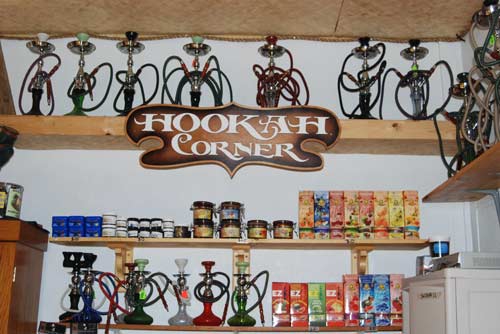DISCOVER NORTH SHORE
Hookah History

Following the European introduction of tobacco in India, the hookah, or water pipe originated in the north-western provinces of India nearly a millennia ago. These primitive hookahs were simple and rugged in design, usually made from a coconut shell base and tube with a head attached. They were designed to smoke opium and hashish, which has created a negative stigma for the hookah being used today. The popularity of the hookah spread through the Persian Kingdom, which included Pakistan, Afghanistan, and much of the Middle Asia and Arab parts of Northern Africa.
On its way through Persia, the hookah adopted a larger head for the smoking of Tombeik, a dark tobacco grown in modern day Iran. Tombeik was rinsed and packed in the head of the hookah where hot coal was applied directly to the wet tobacco, which gave it a stronger flavor. These larger heads and style of hookah were referred to as ghelune in Persia. Today, the hookahs designed in the Persian Empire are still hand-crafted and cut from wood. In the 19th century, cigarettes gained in popularity due to its availability and portability. Women who often stayed in the home, continued to smoke the ghelune for entertainment and as a favored pasttime.
About 500 years ago, the hookah made its way into Turkey and experienced a surge in popularity among the upper class and intellectuals leading to another design alteration. The hookah grew in size and complexity resembling the designs we see today. Brass and glass replaced wood and intricate paintings and mosaics were added for beauty and elegance. Centuries later, hookah coffee shops sprang up and were commonplace throughout Turk society. A hookah bar waiter rivaled the stature of the modern chef because of the skill required to prepare the hookah for smoking. In addition to mastering the art of packing and moistening the hookah, bar waiters were schooled in the often-complex etiquette of hookah smoking. For example, it was considered rude to touch the coals during any step of the preparation or smoking process.
Today, hookah bars are social places where people meet to discuss politics and current events. In Kuwait and Saudi Arabia, the hookah bars are for men only, though in some Muslim countries the hookah is considered haram, or forbidden.
In most hookah-smoking countries, Naklia shisha is served. Naklia shisha is a combination of foreign tobaccos, honey molasses and dried fruit. Filtered through ice water, the smoke is made cool and soothing to the user. Slowly, society is accepting the hookah as more of a pipe for tobacco instead of illegal drugs, as was its original use. The hookah has been growing in popularity in the United States and Europe since the experimentation of the 1960's. Today, hookahs can be found in every college smoke shop and Middle Eastern market throughout the United States and is also growing in popularity in Japan. Hookah bars and lounges have become popular all over the world, including right here in Hawaii.
For more information about the hookah, or to learn more about purchasing your own hookah, go to www.chronichawaiian.com or visit Brian Santos the North Shore Smoke Shop in Haleiwa.

Click to Book go Mokulele Flight
8406e49d-816a-48c1-a3d7-6177053763fc|0|.0